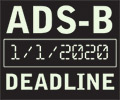 The January 1, 2020 deadline for ADS-B compliance may seem distant at present, but father time doesn’t take many breaks and it will be here before you know it. The numbers don’t lie, and the vast majority of the General Aviation fleet still needs to make the upgrade. It’s important to plan ahead for this deadline, as supply chain and scheduling logjams should be expected the closer we get. Below are several key points about ADS-B as well as a new logo we’ll be using in future issues as added reminders. Please consult with your maintenance provider for more information on options specific to your aircraft.
The January 1, 2020 deadline for ADS-B compliance may seem distant at present, but father time doesn’t take many breaks and it will be here before you know it. The numbers don’t lie, and the vast majority of the General Aviation fleet still needs to make the upgrade. It’s important to plan ahead for this deadline, as supply chain and scheduling logjams should be expected the closer we get. Below are several key points about ADS-B as well as a new logo we’ll be using in future issues as added reminders. Please consult with your maintenance provider for more information on options specific to your aircraft.
With ADS-B, pilots for the first time see what controllers see: displays showing other aircraft in the sky. Cockpit displays also pinpoint hazardous weather and terrain, and give pilots important flight information, such as temporary flight restrictions.
ADS-B also provides greater coverage since ground stations are so much easier to place than radar. Remote areas without radar coverage, like the Gulf of Mexico and parts of Alaska, now have surveillance with ADS-B.
What is the difference between ADS-B Out and ADS-B In?
ADS-B Out refers to an aircraft broadcasting its position and other information. ADS-B In refers to an aircraft receiving the broadcasts and messages from the ground network such as TIS-B and FIS-B. ADS-B In is not mandated by the ADS-B Out rule. If an operator chooses to voluntarily equip an aircraft with ADS-B In avionics, a compatible display is also necessary to see the information. Refer to AC 20-165B for information on ADS-B OUT and AC 20-172B on ADS-B IN installation and certification.
Under the rule, ADS-B Out performance will be required to operate in:
1. Class A, B, and C airspace.
2. Class E airspace within the 48 contiguous states and the District of Columbia at and above 10,000 feet MSL, excluding the airspace at and below 2,500 feet above the surface.
3. Class E airspace at and above 3,000 feet MSL over the Gulf of Mexico from the coastline of the United States out to 12 nautical miles.
4. Around those airports identified in 14 CFR part 91, Appendix D.
ADS-B in pilot cockpit advisory services consists of Flight Information Service-Broadcast (FIS-B) and Traffic Information Service-Broadcast (TIS-B). These are free services transmitted automatically to aircraft equipped to receive ADS-B. •
Source: https://www.faa.gov/nextgen/equipadsb/faq
